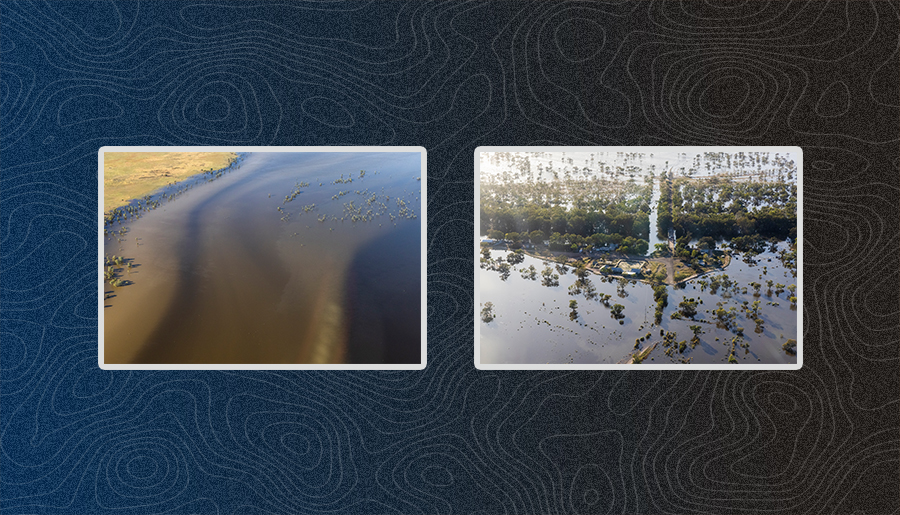Unfortunately, Australia’s epidemic of floods didn’t end in 2022. On February 9, 2023, flash flooding smashed a bunch of NSW. Unfortunately, some areas in Sydney, the Illawarra, and the South Coast have been inundated with rain, with Shoalhaven receiving a whopping 368mm of the stuff.
According to the State Emergency Service (SES), they received over 600 calls from folks asking for help. Moreover, this organisation also conducted 31 flood rescue operations
It’s worth noting that this hasn’t been the only flood event to create problems for Australia in 2023. Back in January, swaths of Western Australia, South Australia, and the Northern Territory were underwater.
Which brings us to three questions you might want answering:
- How is NSW supporting its flood victims?
- What was the deal with the January floods?
- How can I financially support these people?
So, without any further ado, let’s answer these Q’s right now.
NSW’s Flood Payment Programmes
As of February 10, the following programs are available for residents of specific NSW LGAs:
- Disaster Recovery Allowance — A short-term payment scheme if you’ve lost income due to a flood.
- Australian Government Disaster Recovery Payment — A lump sum of money for individuals who have been gravely affected by NSW’s floods. This scheme gives adults a $1000 payment and kids a $400 payment.
- New Zealand Disaster Recovery Allowance — A short-term payment scheme for New Zealanders who have lost their income due to NSW’s flood.
- New Zealand Disaster Recovery Payment — A lump sum of money for New Zealanders who have been gravely affected by NSW’s floods.
- Disaster Relief Grant — A programme that helps people replace essential household items and rebuild their homes.
- Rental Support Payment — A series of payments that help cover accommodation costs for people who are unable to live in their homes.
- Back Home Grant — A $20,000 payment that helps cover the costs of restoring a flood or storm damaged property.
Unpacking January’s Floods
Western Australia’s Floods
Back in January, the ex-tropical cyclone Ellie created a tonne of chaos across Western Australia. This weather event caused so much rain that the Willare region of Fitzroy River peaked at 10.6 metres high. In the Kimberley region, the flood hit over 100 homes and displaced 280 of the area’s residents.
“This has been a traumatic experience for people, and people are doing it tough, and we will have to do everything we can to make sure there is mental health support on the ground,” said Prime Minister Anthony Albanese at the time.
“When you go and look at the damage that was done to the bridges and the roads, you see the power of this water and the difference it has made.
“What is extraordinary is that there isn’t a greater human cost. You can rebuild roads, you can rebuild houses, you cannot rebuild lives.”
South Australia’s Floods
South Australia’s Riverland region was also messed with by said weather event. It led to a 78-year-old local man tragically dying. His body was discovered by police and the SES after 20 hours of investigating.
As of the time of writing, the man’s family hasn’t made a statement.
The Northern Territory Floods
The ex-tropical cyclone Ellie decided to move across the Northern Territory in the second week of January. This caused a tonne of rain to pummel the region. Around a dozen communities had their access to roads cut off from this ordeal.
As Lachlan Moulton, a man in the remote community of Yuendumu, said at the time; “Ten years, more or less, I’ve spent in Central Australia, I have seen some bad rainfall before.”
“But I’ve never seen the [Napperby Creek] flow like that before. It was a raging torrent when we saw it yesterday.”
Related: Is the Wild Weather in Australia Now Due to Climate Change? We Explain
Related: Do You Have ‘Weather Fatigue’? You’re Not the Only One, But It Can Be Conquered
How You Can Help These Communities
Western Australia
To help the flooded folks of Western Australia, you can donate to the Lord Mayor’s Distress Relief Fund. The funds from this programme will be used to help flood-impacted people in the Kimberley region.
“This is the worst of Western Australia in terms of Mother Nature, but often we have seen in the past it produces the best of West Australian spirit,” said Perth’s Lord Mayor, Basil Zempilas.
“Helping one another, contributing for one another, making sure that people give whatever they can afford to give to help their fellow West Australians affected by this one-in-100-year flood.”
You can donate to the Lord Mayor’s Distress Relief Fund by following the link here.
South Australia
Foodbank SA is supporting those who really need it. This organisation is helping South Australians who’ve been hurt by the floods by providing them with meals. They are currently requesting food and monetary donations from the general public.
Moreover, Foodbank SA said, “100% of your donation will be used to get food and water to those who need it the most in the Riverland. For every $1.00 donated to Foodbank, we can purchase $6.00 worth of food, thanks to our relationship with food retailers and manufacturers.”
You can donate to Foodbank SA by following the link here.
The Northern Territory and NSW
Rural Aid is providing support to farmers in the NT. They are also currently asking for donations. As of writing, $50 can buy hay to feed livestock, $150 will provide someone with in-person counselling, $300 will provide clean drinking water, and $500 will give a farmer financial support.
If you donate to this organisation, your money may also be used to help rural flood-affected communities in West Australia, South Australia, NSW, and Victoria. You can donate to Rural Aid by following the link here.
Read more stories from The Latch and subscribe to our email newsletter.







